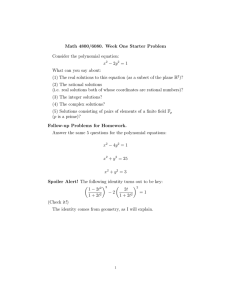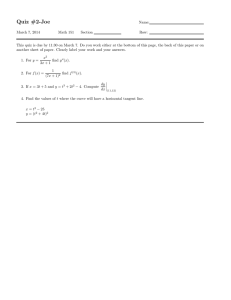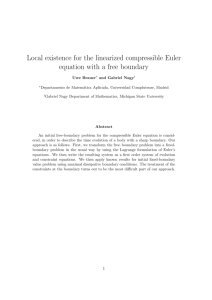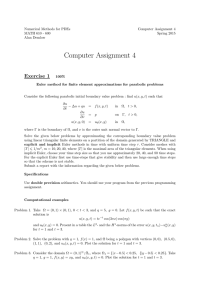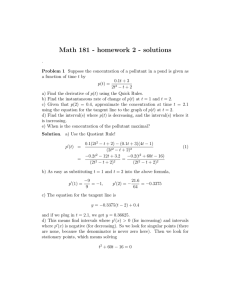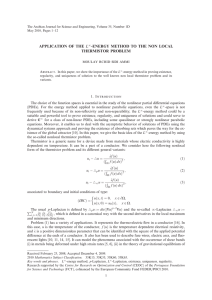Solutions to class exercises
advertisement
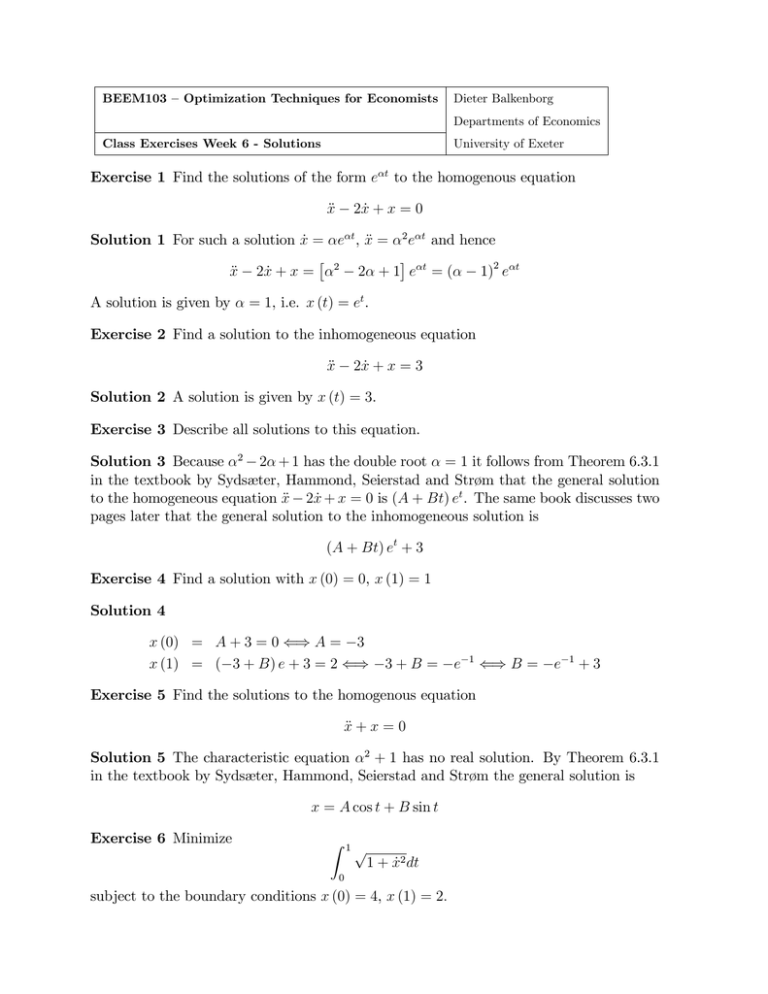
BEEM103 –Optimization Techniques for Economists Dieter Balkenborg Departments of Economics University of Exeter Class Exercises Week 6 - Solutions Exercise 1 Find the solutions of the form e x• t 2x_ + x = 0 Solution 1 For such a solution x_ = e t , x• = x• A solution is given by 2x_ + x = to the homogenous equation 2 e t and hence 2 +1 e t =( 2 1)2 e t = 1, i.e. x (t) = et . Exercise 2 Find a solution to the inhomogeneous equation x• 2x_ + x = 3 Solution 2 A solution is given by x (t) = 3. Exercise 3 Describe all solutions to this equation. Solution 3 Because 2 2 + 1 has the double root = 1 it follows from Theorem 6.3.1 in the textbook by Sydsæter, Hammond, Seierstad and Strøm that the general solution to the homogeneous equation x• 2x_ + x = 0 is (A + Bt) et . The same book discusses two pages later that the general solution to the inhomogeneous solution is (A + Bt) et + 3 Exercise 4 Find a solution with x (0) = 0, x (1) = 1 Solution 4 x (0) = A + 3 = 0 () A = 3 x (1) = ( 3 + B) e + 3 = 2 () 3+B = e 1 () B = e 1 +3 Exercise 5 Find the solutions to the homogenous equation x• + x = 0 Solution 5 The characteristic equation 2 + 1 has no real solution. By Theorem 6.3.1 in the textbook by Sydsæter, Hammond, Seierstad and Strøm the general solution is x = A cos t + B sin t Exercise 6 Minimize Z 1 p 1 + x_ 2 dt 0 subject to the boundary conditions x (0) = 4, x (1) = 2: Solution 6 Let F = p 1 + x_ 2 . We have 1 1 @F 1 @F = 0, = 1 + x_ 2 2 2x_ = 1 + x_ 2 2 x_ @x @ x_ 2 @ 2F @ 2F = =0 @ x@t _ @ x@x _ 3 1 @ 2F 1 = 1 + x_ 2 2 2x_ x_ + 1 + x_ 2 2 @ x@ _ x_ 2 1 x_ 2 1 1 = p +1 = p >0 2 2 2 1 + x_ 1 + x_ 1 + x_ 1 + x_ 2 The Euler equation is hence in this case 1 1 0= p x• () x• = 0 2 1 + x_ 1 + x_ 2 The general solution to x• = 0 is x = At + B. To …t the boundary conditions we must have x (0) = B = 4 x (1) = A + 4 = 2 , A = Thus x (t) = 2 2t + 4 Exercise 7 Minimize Z 1 x2 + 2txx_ + t2 x_ 2 dt 0 subject to the boundary conditions x (0) = 0, x (1) = 2: Solution 7 @F = 2x + 2tx, _ @x @ 2F = 2x + 4tx, _ @ x@t _ @F = 2tx + 2t2 x_ @ x_ @ 2F @ 2F = 2t, = 2t2 @ x@x _ @ x@ _ x_ The Euler equation is 2x + 2tx_ 0 2x + 4tx_ + 2tx_ + 2t2 x• 4tx_ + 2t2 x• 2 () x• = x_ for t 6= 0 t = = Let u = x. _ Then the last equation becomes du = dt 2 2 u t This is a separable di¤erential equation which we can solve as follows 1 du Z u 1 du u ln juj ln juj juj = = = = = 2 dt t Z 2 dt t 2 ln jtj + C ln (jtj) 2 + C = ln t t 2 or u = t 2 2 where = ln C. Next dx = u= dt Z x = t 2 t 2 dt = t 1 +D The only function possible which could in addition satisfy x (0) = 0 would be obtained for = 0 (otherwise the function would not be de…ned at zero) and A = 0, i.e., we would have x (t) = 0 for all t. However, x (2) = 2 would then not be possible. Hence we cannot …nd a solution and suspect that none exists. Exercise 8 Find the Euler equation for the Ramsey problem Z T U f (K (t)) K_ (t) e rt dt 0 subject to the boundary conditions x (0) = 4, x (1) = 2: Use the relative rate of change _ _ consumption C=C where C = f (K) K. Solution 8 For this and the next exercise see Sydsæter, Hammond, Seierstad and Strøm Section 8.4: Exercise 9 Solve the equation in the case f (K) = bK; U (C) = C 1 v = (1 3 v).
